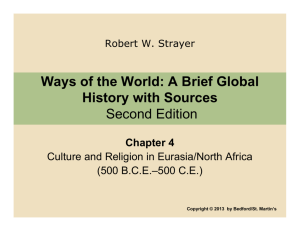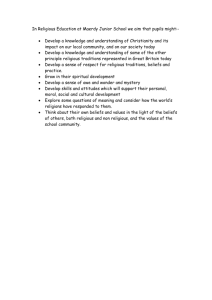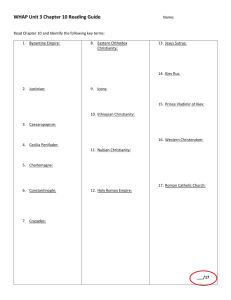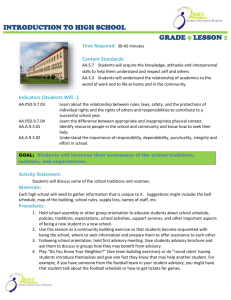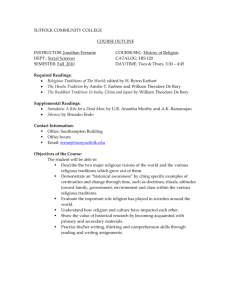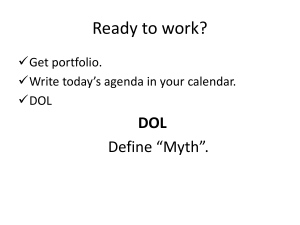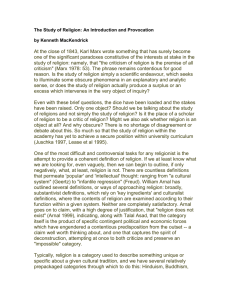REL 1110 Laura Ammon - General Education Program
advertisement
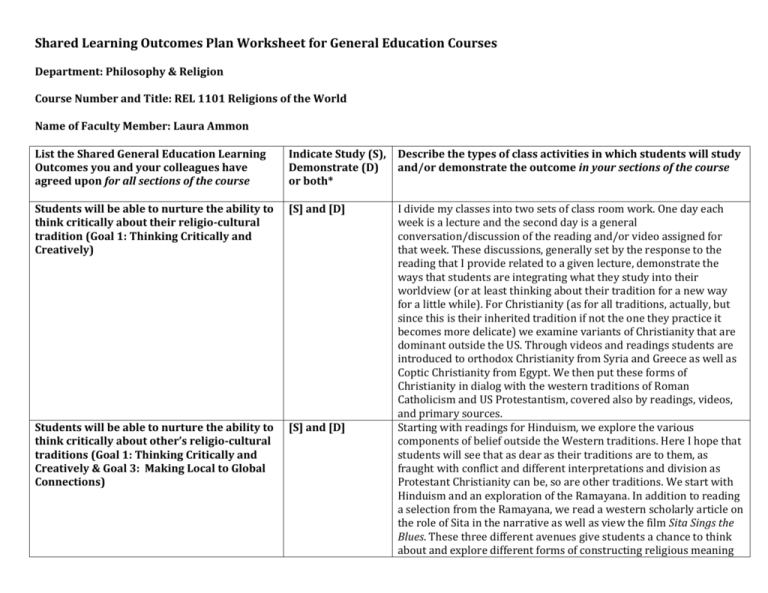
Shared Learning Outcomes Plan Worksheet for General Education Courses Department: Philosophy & Religion Course Number and Title: REL 1101 Religions of the World Name of Faculty Member: Laura Ammon List the Shared General Education Learning Outcomes you and your colleagues have agreed upon for all sections of the course Indicate Study (S), Demonstrate (D) or both* Describe the types of class activities in which students will study and/or demonstrate the outcome in your sections of the course Students will be able to nurture the ability to think critically about their religio-cultural tradition (Goal 1: Thinking Critically and Creatively) [S] and [D] Students will be able to nurture the ability to think critically about other’s religio-cultural traditions (Goal 1: Thinking Critically and Creatively & Goal 3: Making Local to Global Connections) [S] and [D] I divide my classes into two sets of class room work. One day each week is a lecture and the second day is a general conversation/discussion of the reading and/or video assigned for that week. These discussions, generally set by the response to the reading that I provide related to a given lecture, demonstrate the ways that students are integrating what they study into their worldview (or at least thinking about their tradition for a new way for a little while). For Christianity (as for all traditions, actually, but since this is their inherited tradition if not the one they practice it becomes more delicate) we examine variants of Christianity that are dominant outside the US. Through videos and readings students are introduced to orthodox Christianity from Syria and Greece as well as Coptic Christianity from Egypt. We then put these forms of Christianity in dialog with the western traditions of Roman Catholicism and US Protestantism, covered also by readings, videos, and primary sources. Starting with readings for Hinduism, we explore the various components of belief outside the Western traditions. Here I hope that students will see that as dear as their traditions are to them, as fraught with conflict and different interpretations and division as Protestant Christianity can be, so are other traditions. We start with Hinduism and an exploration of the Ramayana. In addition to reading a selection from the Ramayana, we read a western scholarly article on the role of Sita in the narrative as well as view the film Sita Sings the Blues. These three different avenues give students a chance to think about and explore different forms of constructing religious meaning Students will be able to nurture the ability to recognize various means for interpreting critically cultural constructions of meaning (Goal 1: Thinking Critically and Creatively) [S] and [D] Students will be able to nurture the ability to communicate effectively and meaningfully with peoples hailing from disparate religiocultural communities (Goal 2: Communicating Effectively & Goal 3: Making Local to Global Connections) [S] and [D] Students will be able to nurture the ability to generate empathy for the religio-cultural other (Goal 4: Understanding Responsibilities of Community Membership) [S] and [D] and interpreting that meaning academically. We also cover similarities and differences between Thich Nhat Hahn and the Dalai Lama’s forms of Buddhism through readings and video statements from both of them. I ask students to write comparatively about these differences on their exams as well as in a project assignment. I begin the semester with Russell McCutcheon’s article What is the Academic Study of Religion? In this piece, McCutcheon sets out a distinction between religious education (i.e. what happens in church) and education about religion which is the foundation of the academic study of religion in the US. His distinction is then one that we come back to in writing and discussions during the semester, continuing to clarify and develop our own sense of the ways that religious meaning is interpreted by practitioners and by academics. I focus on talking about other traditions in a ‘value-free’ fashion. Particularly in class conversations about different religions, I ask students to rephrase when they use terms like ‘weird’ and ‘silly.’ I realize they are trying to wrestle with the meaning of those traditions, to recognize what is different and sometimes to misrecognize what is similar. I encourage them to think about what is motivating their question and reaction and to think about how a person practicing that religion might respond. This becomes particularly poignant with Judaism, where our students at App are confused by Judaism’s’ rejection of Jesus as a fulfillment of prophecies found in the Hebrew Bible and appropriated by Christianity. I use some role play in the classroom to get to students to imagine how a Jewish practitioner might answer their questions. This often helps in reframing questions and thoughts about other traditions. I ask students on exams and in their project, to describe and explain a belief or practice from the ‘inside’ — they are required to describe a belief and practice as it might appear to a practitioner as opposed to how it appears to an outsider. This is especially useful with Islam and with women’s issues in various traditions. Writing and discussion topics are designed to cultivate students’ sense of empathy and imagination about the ways others live their lives I keep my classroom as interactive as possible, attempting to meet students where they are with regard to different religious worldviews. Our class discussions revolve around key beliefs, practices, and ideas about the major religions we study and understanding them in relationship to our own understandings of the world. In this manner, we assess similarities between their view of the world and world views outside of their own. * For each outcome, indicate whether students in your sections of the course will: o Study (S) it in lectures, readings, discussions, or activities o Demonstrate (D) their achievement of it in course assignments, exams, or projects o Both study (S) and demonstrate (D) it Form prepared by P. Marty 3/8/12

